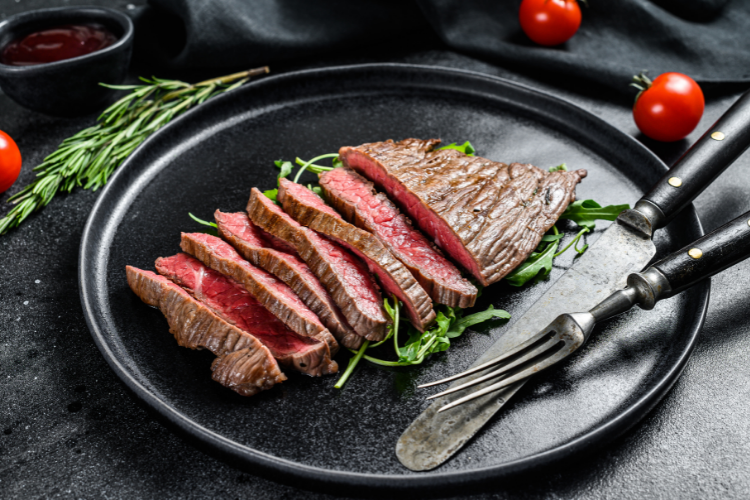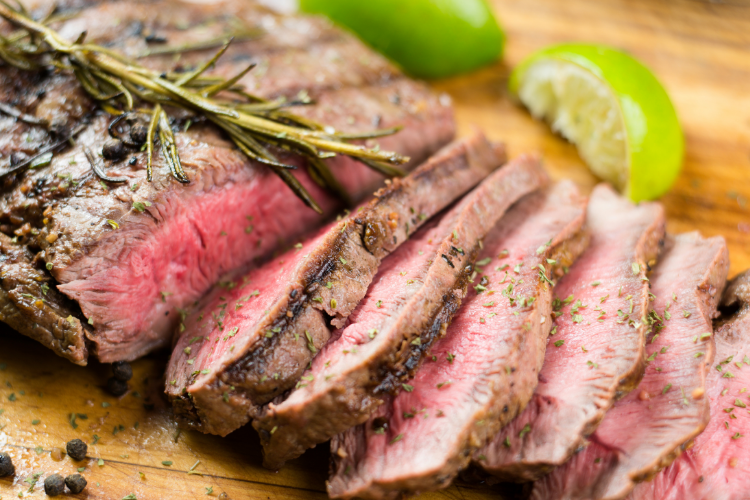- FarmFoods Market Review: Quality Meats? - April 12, 2023
- Rastelli’s Review: Is Their Meat Delivery Service Worth It? - April 12, 2023
- Porter Road Review: Pros and Cons - April 12, 2023
If you’re looking for a flavorful and delicious cut of beef to grill, but don’t want to spend a lot of money, consider the Bavette steak. These wonderful steaks are more affordable than other options, which adds to their appeal. The fact that they won’t cost you an arm and a leg makes Bavette steaks a popular choice when grilling for a large gathering.
But what, exactly, is a Bavette steak? And what’s the best way to prepare one? Our guide on Bavette steak will tell you everything you need to know, so keep reading to find out!
Key Details Up Front
Bavette steaks are a flavorful and tender cut of beef that people often confuse with Flank steaks or Skirt steaks. Unfortunately, its name makes it a less than memorable cut. However, in recent years, the Bavette steak has started to become a more popular choice as grillers enjoy its excellent taste while thrifty spenders appreciate its low price.
What is a Bavette Steak?

If you’re not familiar with the Bavette steak, don’t worry. We’re here to set the record straight. This cut of steak comes from the French word ‘Bavette,’ which means ‘bib.’ This is in reference to the long, flat shape of the steak itself.
Why haven’t you heard of a Bavette cut before now? Great question. The biggest reason is the name on the label in the grocery store. While your butcher will know what you’re talking about when you mention a Bavette steak, the supermarket labels it as a ‘Sirloin Flap.’ Not exactly the most appetizing of names.
The actual Bavette cut is part of the Sirloin Primal. It is a close relative to the Flank steak, which is why the two are often mixed up. However, when compared to one another, Bavette steaks are much more tender and provide better marbling than their Flank steak counterparts.
You’ll find that the most distinct characteristics of the Bavette steak are its open and loose meat structure along with its powerful beefy flavor. These factors make Bavette steaks ideal if you want to try out a marinade while still getting a strong steak taste.
However, similar to the Flank cut, Bavettes offer a state that is similar to other cuts along with the Sirloin Primal and a coarse texture perfect for soaking up juices. That means if you don’t prepare the Bavette cut correctly, you could wind up serving a meal that tastes like leather to your guests.
On the other hand, when you cook it the right way, Bavette steaks are juicy, delicious, and tender, offering amazing meaty flavor. The taste of Bavette steaks can be additionally enhanced by dry aging. Most dry-aged cuts are hung for at least three weeks, which makes them more delicious and tender.
Bavette Steak Taste
Bavette is a cut that is rich in flavor and beefy steaks, just like other premium cuts from a cow. This steak is high in minerals and proteins, which makes it a good cut for nutritional purposes. Compared to other cuts of steak, the Bavette cut has a lot of fiber.
Location on the Cow
The Bavette cut is located on the abdominal muscles or lower chest of the cow. Since there are among the most active muscles on the cow, it’s easy to see why this cut is an excellent option for different types of meals. Since its texture is loose, Bavette steaks don’t get very chewy or tough. As a result, you get a juicy and delicious steak.
Best Places to Find Bavette Steak Cuts

Now that we have you wanting a Bavette steak, you’re probably wondering where you can get your hands on one. Unfortunately, you’re not likely to walk into your local supermarket or grocery store and find a slice of this underrated cut of steak.
Even though the Bavette is growing in popularity, it’s still not as widely available as strip steaks, ribeyes, or filets. There’s no guarantee you’re going to find it in the meat aisle of a grocery store. But don’t worry. There’s a solution to our steak conundrum.
There’s a good chance your local butcher can hook you up with a nice piece of Bavette steak. However, keep in mind that you might need to phone ahead. There are only two to four pounds of Bavette cuts available per cow, so there isn’t a lot to go around.
But even if you don’t have a butcher nearby, don’t worry. There are many online meat companies through which you can purchase your favorite cuts of steak. This includes popular options like Rastelli’s, Crowd Cow, or Snake River Farms. Just place your order on the website and wait for the meat to arrive.
Since the Bavette cut is easy to mistake with a Flank steak or even a Skirt steak, you want to make sure you’re getting what you asked for. Take some additional time to be 100% sure the cut you’re getting is a Bavette steak. And if necessary, don’t hesitate to confirm with your butcher that it’s exactly what you’re getting.
How to Prepare Your Bavette Steak

Now you have your Bavette steak in hand, it’s time to cook it. Your best options are either pan-frying or grilling it. Either of these methods will result in a delicious and flavorful steak.
While cooking your steak, it’s best to pay close attention to what you’re doing. This is because one end of the cut is thick and the other is thin, which means it’s not going to cook evenly. The thin end will cook much faster than the thicker. Cut off any excess fat before you season your steak, then find your favorite dry rub or marinade and apply it.
You can cook your Bavette steak just like you would any other steak. Keep it on the grill or pan until it reaches the right internal temperature. For example, if you want it rare, pull it off when the temperature reaches 120-degrees. Just remember not to cook it more than medium as the steak will continue to cook even after you remove it from the heat.
Allow your steak to rest for 10 minutes before you start cutting it. Doing so allows the juice to redistribute throughout the cut. Additionally, be sure you cut your Bavette against the grain. This ensures that your steak is nice and tender.
Seasoning Your Bavette
When you’re ready to season your steak, your best bet is to use a dry rub or some steak seasoning. Or you can never go wrong with Himalayan salt (pink salt) and ground black pepper.
Others opt to use a marinade consisting of several flavorful ingredients like barbecue sauce, soy sauce, onions, or garlic. Let the steak soak up the savory juices for at least 12 hours before you throw it on the grill or in the pan.
Getting the Grill Ready
If you decide to grill your Bavette steak, here are a few tips as you prepare the grill:
- Bring the grill temperature up to 225-degrees for perfect low-heat cooking
- Keep the coals off to one side so you can use the two-zone cooking method effectively
Using this cooking method will give you a delicious, juicy, tender steak that won’t dry out and will have a nice, even cook.
Cooking Your Bavette Steak

Now it’s finally time to cook your Bavette cut steak. Remember to use the two-zone or indirect heating method we mentioned to ensure your steak is cooked evenly. Give the steak a good sear on both sides for a few minutes, then move the steak to the indirect side to finish it off.
When the grill is ready, make sure the thicker part of the steak is near the hotter area of the surface. Just remember not to put it directly over the heat. Let the meat heat slowly so the middle gets warm and then give it a nice sear to finish it off.
Grill the steak on one side for about five minutes, then flip it over and let it cook for another three or four minutes. If you like a steak more on the done side, keep it on the grill a little longer. Flip it a few more times to give it a nice even sear, then baste it in some melted butter and garlic to bring out the steak’s juiciness.
Once you’re sure the steak is to your liking, set it aside on a plate and let it rest for at least ten minutes. Slice it up, serve it up, and enjoy!
FAQs
Unless you’re a steak connoisseur, there’s a good chance you’ve never heard of a Bavette steak. It’s not very popular and most people can’t tell the difference between a Flank steak and a Bavette steak. To provide additional information, here are some commonly asked questions about Bavette cuts:
Answer: When compared to other cuts of beef, Bavette is one of the healthiest you’ll find. This is due to it coming from the Sirloin Primal, which is a lean part of the cow and doesn’t have an external cap of fat.
However, it marbles very well, just like the Skirt and Flank steak do. This makes it an ideal cut to grill or fry, even if it’s the only thing you’re going to eat. Plus, the marbling serves to keep the Bavette steak nice and tender, and juicy.
Or, if you want to keep things extra healthy, you could use your sliced Bavette with fajitas. Slice up some peppers and onions and serve them with tortillas for a delicious, healthy meal.
Answer: If you’ve never heard of Wagyu, you’re missing out. This delicious beef is only from Japan and exclusively comes from Kuroge Washu cows. Most of the Wagyu beef you can get your hands on in the US is imported. However, there are some small herds of Kuroge Washu in the United States that are raised specifically for their meat.
There are online meat delivery companies that offer American Wagyu, so if you want to have some Wagyu Bavette delivered right to your doorstep, you can do so. Plus, most of the online sites offer 100% grass-fed, all-natural beef.
Answer: We’ve already mentioned how Bavette steak is identified by its visible grain and open/loose structure. These fibers are an important part of the steak, as they make the steak tender and juicy unless it’s overcooked. If the fibers are short, the meat will be tender.
That means it’s critical that you slice your Bavette steak using a very sharp knife. Cut perpendicular to the muscle fibers, which are easy to identify when cutting up a Bavette steak. Doing so will give you tender, juicy slices.
If you cut the steak with the grain, or in the same direction as the muscle fibers, you’ll end up with chewy slices. So, be sure to use a sharp knife and cut against the grain for the best results.
Answer: This is probably the most common question people have about Bavette steak. And the answer is simple: any way you like!
Bavette steak can be grilled, pan-fried, or even oven-roasted. The important thing is to not overcook it, as that will make the meat tough and chewy.
For a medium-rare steak, aim for an internal temperature of 145 degrees Fahrenheit. And for a medium steak, aim for an internal temperature of 160 degrees Fahrenheit.
Remember to let the steak rest for at least ten minutes before cutting into it, as that will help keep all the juices in and make for a juicier steak.
Answer: The main difference between Bavette and Flank steak is the amount of marbling. Bavette steak has more intramuscular fat, which gives it more flavor.
Flank steak, on the other hand, is a leaner cut of meat. It’s also tougher because there’s less fat to lubricate the fibers.
However, both Bavette and Flank steak are fairly similar in terms of taste and texture. So, if you’re looking for a leaner steak, go with Flank. If you’re looking for a more flavorful steak, go with Bavette.
Great Quality Steak on a Budget
Bavette cuts are an excellent and versatile steak that isn’t very well known or popular. While most people are fawning over ribeyes, t-bones, and filets, Bavettes are the secret that no one else knows about. Now that you’re in on it, you can create delicious, fantastic meals for you, your family, and your guests that will have them asking for seconds.

